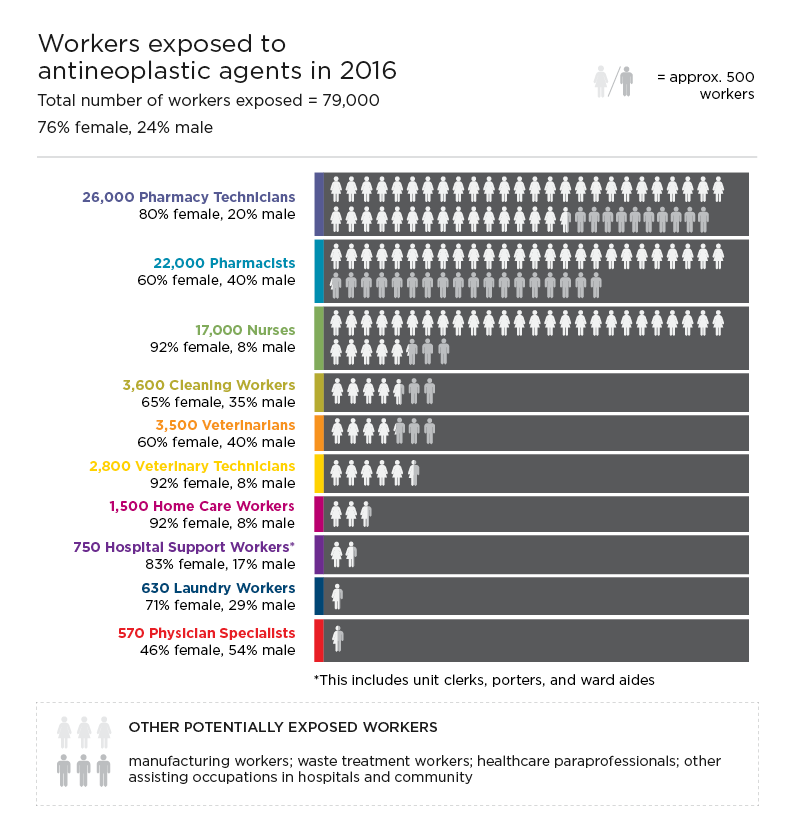Workplace exposure to antineoplastic agents
Workplace exposure to antineoplastic agents
Antineoplastic agents, also called chemotherapy or cytotoxic drugs, are used to treat various cancers.[1] Despite their therapeutic benefits for patients, healthcare workers exposed to antineoplastic agents are at increased risk of adverse health outcomes.[2] The International Agency for Research on Cancer (IARC) has classified some antineoplastic agents as known, probable, or possible carcinogens.[2,3] CAREX Canada estimates that 79,000 Canadian workers are exposed to antineoplastic agents.[4,5] Exposure can occur in various workplaces including home care, veterinary care, community pharmacies, and hospitals.[6]
CAREX Canada has developed two types of resources to help organizations address exposures to antineoplastic agents – the first helps to better understand exposures in the workplace and the second helps to control exposures in health care settings.
CAREX Canada’s resources on workplace exposure to antineoplastic agents
CAREX Canada offers the following resources to help organizations better understand exposures to antineoplastic agents:
Profile: Our carcinogen profile for antineoplastic agents provides general information about antineoplastic agents and why they were classified as carcinogens, lists the regulations and guidelines related to antineoplastic agent exposure in Canada, and describes how exposure takes place in the workplace. The antineoplastic agents profile is available here.
Occupational exposure estimates: Our estimates use a variety of data sources to estimate the prevalence and levels of exposure experienced in Canadian workplaces. The estimates for antineoplastic agent exposure are available here.

Webinar – Exposure to Antineoplastic (Cytotoxic) Drugs in Canadian Workplaces: Presented in partnership with WorkSafeBC, this webinar recording presents our estimates of exposure to antineoplastic (cytotoxic) agents in Canadian workplaces. It also offers information about how to best address this exposure and includes a Q&A with webinar participants.
CAREX Canada’s resources on reducing workplace exposure to antineoplastic agents
Despite the existence of several policies, guidelines, and best practices on controlling exposure to antineoplastic agents, compliance among healthcare workers has been poor. [7] Our team conducted research on the different dimensions that affect the safe handling of antineoplastic agents in health care settings and produced resources that can help policy makers and healthcare leaders reduce occupational exposure to antineoplastic agents:
Compendium of policy levers for the safe handling of antineoplastic agents in occupational settings: This tool is a collection of policy levers for the safe handling of antineoplastic agents in different healthcare settings. It was designed to help policy makers create and update their own respective policies. The compendium is available here (XLS).
Prevention framework for handling antineoplastic agents: This tool was designed to help organizations assess and audit their own procedures and plans for the safe handling of antineoplastic agents. It was developed by applying internationally accepted approaches to auditing occupational health and safety management systems. The framework is available here (PDF).
Comparison of policy levers for the safe handling of antineoplastic agents in Alberta, Manitoba, and British Columbia: This report details and compares the various statutes, regulations, policies, guidelines, and standards used in the safe handling of antineoplastic agents across three provinces. It outlines key similarities and differences that policy makers can use to create better-informed policies that protect the health and wellbeing of healthcare workers handling antineoplastic agents. The report is available here (PDF).
Webinar: Reducing occupational exposure to antineoplastic drugs: This webinar presents the findings of our research on the barriers and facilitators that influence the safe handling of antineoplastic agents. It includes results from a literature review, environmental scan, and stakeholder interviews, and was designed to help decision makers and policy implementers create safer environments for workers handling antineoplastic agents.
This study was funded by WorkSafeBC (Innovation at Work program) and Alberta Labour and Immigration (OHS Futures program).
How is CAREX addressing Canadians’ exposures to antineoplastic agents?
CAREX Canada is working with various partners in order to raise awareness, facilitate networks, and support action on addressing occupational exposure to antineoplastic agents. These efforts involve giving presentations, organizing workshops, providing evidence, and more. Examples include:
- Providing evidence to WorkSafeBC to support updating the substance-specific requirements of the occupational health and safety regulation in British Columbia.
- Providing evidence to the Canadian Union of Public Employees and the Alberta Veterinary Medical Association to support them with updating their respective recommendations and bylaws.
References and other resources
Sources
Other resources
Prevention Policies Directory: We also recommend exploring the Prevention Policies Directory, a freely-accessible online tool offering information on policies related to cancer and chronic disease prevention. Providing summaries of the policies and direct access to the policy documents, the Directory allows users to search by carcinogen, risk factor, jurisdiction, geographical location, and document type. For questions about this resource, please contact a member of the Prevention Team at the Canadian Partnership Against Cancer at primary.prevention@partnershipagainstcancer.ca
Subscribe to our newsletters
The CAREX Canada team offers two regular newsletters: the biannual e-Bulletin summarizing information on upcoming webinars, new publications, and updates to estimates and tools; and the monthly Carcinogens in the News, a digest of media articles, government reports, and academic literature related to the carcinogens we’ve classified as important for surveillance in Canada. Sign up for one or both of these newsletters below.
CAREX Canada
School of Population and Public Health
University of British Columbia
Vancouver Campus
370A - 2206 East Mall
Vancouver, BC V6T 1Z3
CANADA
As a national organization, our work extends across borders into many Indigenous lands throughout Canada. We gratefully acknowledge that our host institution, the University of British Columbia Point Grey campus, is located on the traditional, ancestral and unceded territories of the xʷməθkʷəy̓əm (Musqueam) people.


